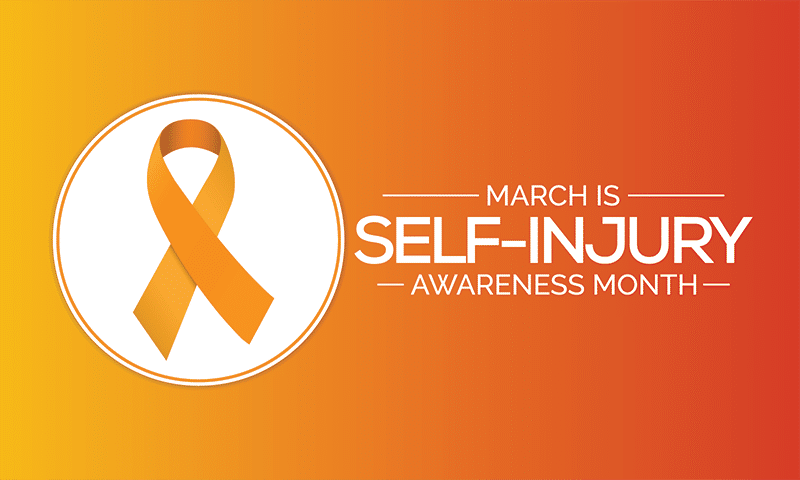Self-harm, clinically referred to as Non-Suicidal Self-Injury (or NSSI) or just self-injury, is a term for deliberately inflicting physical harm to one’s body. Self-injury behaviors are most common among adolescents and young adults, with the age of onset typically between 12 and 14 years old.
In most cases, those who habitually injure themselves are trying to find an outlet to:
- Manage stress
- Distract from emotional distress
- Replace feelings of numbness or low self-esteem
- Control feelings of helplessness
- Punish themselves for perceived shame or express self-hate
- Self-nurture or self-care
For most, self-harming behaviors are private acts that aren’t attempts to seek attention or manipulate others. In most cases, individuals who harm themselves keep their behavior a secret, rarely talking about it with others, and restricting injuries to private or covered-up areas.
As much as 4% of the population (13 million people) in the United States have engaged in some form of self-injury as a coping mechanism.
The Self-Injury Paradox
Self-harming behaviors have a paradoxical effect. As we mentioned, most report that they do it to relieve stress or emotional pain. That’s because this self-inflicted pain causes a rush of endorphins, which are neurotransmitters responsible for relieving pain and improving wellbeing.
Symbolically speaking, purposefully injuring yourself may be viewed as an attempt at communicating that which can’t be articulated or spoken. Most individuals who self-injure struggle with emotional expression and suffer from internal conflicts, anxiety, depression, and fallout from physical or sexual abuse.
Common Ways People Self-Harm
Unfortunately, there is a myriad of ways people can self-injure themselves. So of the more common self-injury behaviors include:
- Cutting
- Scratching
- Burning
- Punching or hitting themselves
- Inserting objects under the skin
- Pulling out hair
- Picking the skin
Warning signs to watch out for include:
- Keeping sharp objects, such as knives, razors, etc. in their room
- Wearing long sleeve shirts, sweatshirts, and/or pants at inappropriate times
- Frequent injuries
- A history of problems coping with negative situations/emotions
- Lack of impulse control
- Low-self esteem or self-worth
Challenges in Treating Those Who Self-Harm for Addiction/Substance Abuse
Unsurprisingly, those who engage in self-injury are also prone to engage in substance abuse and addiction. After all, drug and alcohol abuse is a common negative coping mechanism that offers false hope of emotional/physical escape. Substance abuse can also be a form of self-harm, especially in the form of binging (drugs or alcohol).
When drugs and alcohol are used in conjunction with self-injurious behavior, things can get particularly dangerous. Many common substances of abuse decrease physical feelings of pain, along with judgment and fine motor skills. This can cause people who normally inflict relatively minor harm to accidentally hurt themselves severely, possibly fatally.
For these individuals, it’s absolutely essential to treat both the substance abuse and the self-harming behavior (along with any co-occurring emotional or mental disorders) at the same time – with what’s known as dual-diagnosis treatment.
Dual Diagnosis Treatment
Substance abuse and self-harm share have one major thing in common – these behaviors are almost always a response to something else. Whether it’s to self-medicate a mental health disorder (or perceived disorder), emotional disturbance, to try and relieve anxiety or depression, or to forget a traumatic experience, there’s usually some kind of root cause related to a psychological or emotional issue.
Dual diagnosis treatment centers, like our program at Enterhealth, combine treatment for substance abuse with psychological therapy and counseling for mental and emotional disorders. By treating both issues at the same time, dual diagnosis treatment often helps patients feel more comfortable with and optimistic about treatment – making them more likely to participate and view it as a positive experience.
Dual diagnosis treatment is highly effective because it encourages practical, healthy coping skills and techniques to deal with negative feelings like stress, depression, resentment, sadness, and anxiety.
To tackle both conditions at the same time, it’s important to have highly trained medical and psychological practitioners who can diagnose any disorder(s), prescribe needed medications, and administer ongoing therapies for a given mental disorder.
ENTERHEALTH WANTS TO HELP
For more information about the dual-diagnosis treatment offered at Enterhealth, you can check out our mental health diagnosis and treatment page. You can also give us a call at 1.800.388.4601 anytime, day or night, or visit our contact page to leave us a message.




